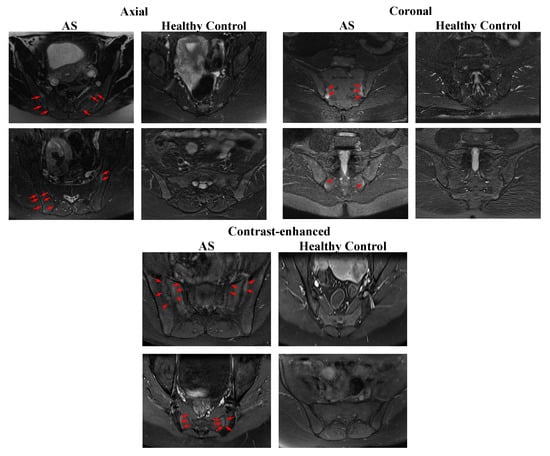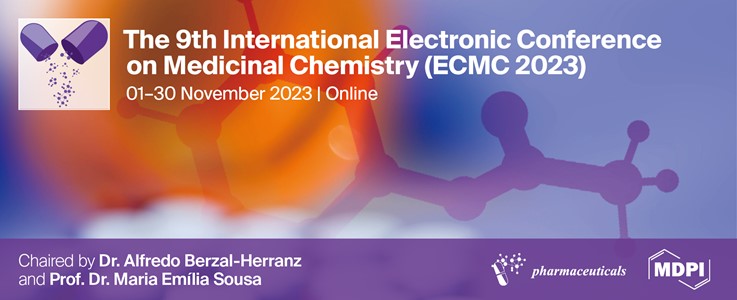-
 MDM2 Inhibition in the Treatment of Glioblastoma: From Concept to Clinical Investigation
MDM2 Inhibition in the Treatment of Glioblastoma: From Concept to Clinical Investigation -
 Role of Macrophage lncRNAs in Mediating Inflammatory Processes in Atherosclerosis and Sepsis
Role of Macrophage lncRNAs in Mediating Inflammatory Processes in Atherosclerosis and Sepsis -
 Therapeutic Potential of EVs: Targeting Cardiovascular Diseases
Therapeutic Potential of EVs: Targeting Cardiovascular Diseases -
 Involvement of the Opioid Peptide Family in Cancer Progression
Involvement of the Opioid Peptide Family in Cancer Progression -
 Cell Adhesion Molecules in Fibrotic Diseases
Cell Adhesion Molecules in Fibrotic Diseases
Journal Description
Biomedicines
Biomedicines
is an international, scientific, peer-reviewed, open access journal on biomedicines published monthly online by MDPI. The Society for Regenerative Medicine (Russian Federation) (RPO) is affiliated with Biomedicines and its members receive discounts on the article processing charges.
- Open Access— free for readers,with article processing charges (APC) paid by authors or their institutions.
- High Visibility: indexed within Scopus, SCIE (Web of Science), PubMed, PMC, CAPlus / SciFinder, and other databases.
- Journal Rank: JCR - Q1 (Pharmacology & Pharmacy) / CiteScore - Q2 (Medicine (miscellaneous))
- Rapid Publication: manuscripts are peer-reviewed and a first decision is provided to authors approximately 14.7 days after submission; acceptance to publication is undertaken in 2.9 days (median values for papers published in this journal in the first half of 2023).
- Recognition of Reviewers: reviewers who provide timely, thorough peer-review reports receive vouchers entitling them to a discount on the APC of their next publication in any MDPI journal, in appreciation of the work done.
- Companion journals for Biomedicines include: IJTM, BioMed and Anesthesia Research.
Impact Factor:
4.7 (2022);
5-Year Impact Factor:
4.9 (2022)
Latest Articles
ASNET: A Novel AI Framework for Accurate Ankylosing Spondylitis Diagnosis from MRI
Biomedicines 2023, 11(9), 2441; https://doi.org/10.3390/biomedicines11092441 (registering DOI) - 01 Sep 2023
Abstract
Background: Ankylosing spondylitis (AS) is a chronic, painful, progressive disease usually seen in the spine. Traditional diagnostic methods have limitations in detecting the early stages of AS. The early diagnosis of AS can improve patients’ quality of life. This study aims to diagnose
[...] Read more.
Background: Ankylosing spondylitis (AS) is a chronic, painful, progressive disease usually seen in the spine. Traditional diagnostic methods have limitations in detecting the early stages of AS. The early diagnosis of AS can improve patients’ quality of life. This study aims to diagnose AS with a pre-trained hybrid model using magnetic resonance imaging (MRI). Materials and Methods: In this research, we collected a new MRI dataset comprising three cases. Furthermore, we introduced a novel deep feature engineering model. Within this model, we utilized three renowned pretrained convolutional neural networks (CNNs): DenseNet201, ResNet50, and ShuffleNet. Through these pretrained CNNs, deep features were generated using the transfer learning approach. For each pretrained network, two feature vectors were generated from an MRI. Three feature selectors were employed during the feature selection phase, amplifying the number of features from 6 to 18 (calculated as 6 × 3). The k-nearest neighbors (kNN) classifier was utilized in the classification phase to determine classification results. During the information phase, the iterative majority voting (IMV) algorithm was applied to secure voted results, and our model selected the output with the highest classification accuracy. In this manner, we have introduced a self-organized deep feature engineering model. Results: We have applied the presented model to the collected dataset. The proposed method yielded 99.80%, 99.60%, 100%, and 99.80% results for accuracy, recall, precision, and F1-score for the collected axial images dataset. The collected coronal image dataset yielded 99.45%, 99.20%, 99.70%, and 99.45% results for accuracy, recall, precision, and F1-score, respectively. As for contrast-enhanced images, accuracy of 95.62%, recall of 80.72%, precision of 94.24%, and an F1-score of 86.96% were attained. Conclusions: Based on the results, the proposed method for classifying AS disease has demonstrated successful outcomes using MRI. The model has been tested on three cases, and its consistently high classification performance across all cases underscores the model’s general robustness. Furthermore, the ability to diagnose AS disease using only axial images, without the need for contrast-enhanced MRI, represents a significant advancement in both healthcare and economic terms.
Full article
(This article belongs to the Special Issue Artificial Intelligence Applications in Cancer and Other Diseases)
►
Show Figures
Open AccessArticle
A Comparative Study on Cyclodextrin Derivatives in Improving Oral Bioavailability of Etoricoxib as a Model Drug: Formulation and Evaluation of Solid Dispersion-Based Fast-Dissolving Tablets
Biomedicines 2023, 11(9), 2440; https://doi.org/10.3390/biomedicines11092440 (registering DOI) - 01 Sep 2023
Abstract
Etoricoxib, as a model drug, has a poor solubility and dissolution rate. Cyclodextrin derivatives can be used to solve such a problem. A comparative study was run on three cyclodextrin derivatives, namely β-CD, HP β-CD, and SBE β-CD, to solve the drug problem
[...] Read more.
Etoricoxib, as a model drug, has a poor solubility and dissolution rate. Cyclodextrin derivatives can be used to solve such a problem. A comparative study was run on three cyclodextrin derivatives, namely β-CD, HP β-CD, and SBE β-CD, to solve the drug problem through the formulation of solid dispersions and their preparation into fast-dissolving tablets. Preparations utilized different (1:1, 1:2, and 1:4) drug:carrier ratios. Nine fast-dissolving tablets (containing 1:4 drug: carrier) were formulated using Prosolv ODT® and/or F-melt® type C as super-disintegrants. Optimized formulation was chosen based on a 32 factorial design. The responses chosen were the outcomes of the in vitro evaluation tests. The optimized formulation that had the highest desirability (0.86) was found to be SD-HP3, which was prepared from etoricoxib: HP β-CD at a 1:4 ratio using equal amounts of Prosolv ODT® and F-melt® type C. An in vivo evaluation of SD-HP3 on a rabbit model revealed its superiority over the marketed product Arcoxia®. SD-HP3 showed a significantly lower Tmax (13.3 min) and a significantly higher Cmax (9122.156 μg/mL), as well as a significantly higher AUC, than Arcoxia®. Thus, the solubility, dissolution, and bioavailability of etoricoxib were significantly enhanced.
Full article
(This article belongs to the Section Drug Delivery)
►▼
Show Figures
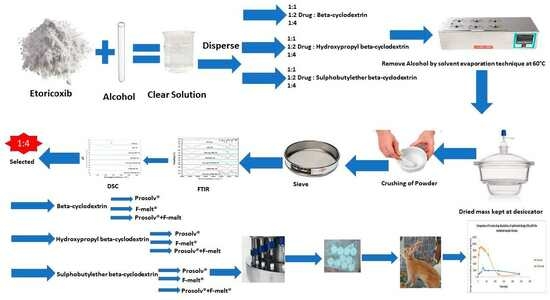
Graphical abstract
Open AccessArticle
Acoustic Voice Analysis as a Useful Tool to Discriminate Different ALS Phenotypes
by
, , , , , , , , and
Biomedicines 2023, 11(9), 2439; https://doi.org/10.3390/biomedicines11092439 - 31 Aug 2023
Abstract
Approximately 80–96% of people with amyotrophic lateral sclerosis (ALS) become unable to speak during the disease progression. Assessing upper and lower motor neuron impairment in bulbar regions of ALS patients remains challenging, particularly in distinguishing spastic and flaccid dysarthria. This study aimed to
[...] Read more.
Approximately 80–96% of people with amyotrophic lateral sclerosis (ALS) become unable to speak during the disease progression. Assessing upper and lower motor neuron impairment in bulbar regions of ALS patients remains challenging, particularly in distinguishing spastic and flaccid dysarthria. This study aimed to evaluate acoustic voice parameters as useful biomarkers to discriminate ALS clinical phenotypes. Triangular vowel space area (tVSA), alternating motion rates (AMRs), and sequential motion rates (SMRs) were analyzed in 36 ALS patients and 20 sex/age-matched healthy controls (HCs). tVSA, AMR, and SMR values significantly differed between ALS and HCs, and between ALS with prevalent upper (pUMN) and lower motor neuron (pLMN) impairment. tVSA showed higher accuracy in discriminating pUMN from pLMN patients. AMR and SMR were significantly lower in patients with bulbar onset than those with spinal onset, both with and without bulbar symptoms. Furthermore, these values were also lower in patients with spinal onset associated with bulbar symptoms than in those with spinal onset alone. Additionally, AMR and SMR values correlated with the degree of dysphagia. Acoustic voice analysis may be considered a useful prognostic tool to differentiate spastic and flaccid dysarthria and to assess the degree of bulbar involvement in ALS.
Full article
(This article belongs to the Special Issue New Insights into Motor Neuron Diseases)
►▼
Show Figures

Figure 1
Open AccessArticle
Multi-Center Real-World Outcomes of Nivolumab Plus Ipilimumab and Chemotherapy in Patients with Metastatic Non-Small-Cell Lung Cancer
by
, , , , , , and
Biomedicines 2023, 11(9), 2438; https://doi.org/10.3390/biomedicines11092438 - 31 Aug 2023
Abstract
Immune checkpoint inhibitors have become the standard of care in the treatment of metastatic non-small-cell lung cancer (NSCLC). The combination of nivolumab plus ipilimumab and chemotherapy has been shown to improve outcomes in terms of overall survival (OS) and progression-free survival (PFS). The
[...] Read more.
Immune checkpoint inhibitors have become the standard of care in the treatment of metastatic non-small-cell lung cancer (NSCLC). The combination of nivolumab plus ipilimumab and chemotherapy has been shown to improve outcomes in terms of overall survival (OS) and progression-free survival (PFS). The aim of this study was to evaluate the outcomes of metastatic NSCLC treated in routine practice on the treatment regimen of the CheckMate 9LA protocol. Medical records of 58 patients treated at Soroka and Bnai Zion Medical Centers between May 2020 and February 2022 were analyzed. All patients were treated with a regimen of platinum-based chemotherapy combined with immunotherapy of nivolumab every three weeks and ipilimumab every 6 weeks. The patients received 2–3 cycles of chemotherapy according to the physician’s choice: platinum-based cisplatin or carboplatin with either pemetrexed or paclitaxel. The median PFS was 10.2 months, longer than that of the 9LA trial (6.7 months). Adenocarcinoma patients exhibited a higher median OS of 13.7 (range 5–33) months than squamous cell carcinoma (SCC) patients at 12.3 (5–20) months and PFS of 10.3 (4–33) months, while squamous cell carcinoma patients had a PFS of 9.2 (4–18) months. Patients whose programmed death ligand-1 (PD-L1) tumor expression level was ≥1% showed a higher median OS than those with PD-L1 expression of less than 1%. Treatment-related adverse events (TRAEs) were reported in 93.1% of patients, mostly grade 1 in severity. The first-line treatment of metastatic NSCLC patients in combination with nivolumab plus ipilimumab and chemotherapy can be given safely in routine clinical practice, with results comparable to those achieved in clinical trials of the regimen.
Full article
(This article belongs to the Special Issue Recent Advances in Immunotherapy for Solid Tumors)
Open AccessReview
Biomarkers for Kidney-Transplant Rejection: A Short Review Study
by
, , , , , and
Biomedicines 2023, 11(9), 2437; https://doi.org/10.3390/biomedicines11092437 - 31 Aug 2023
Abstract
Kidney transplantation is the preferred treatment for end-stage renal failure, but the limited availability of donors and the risk of immune rejection pose significant challenges. Early detection of acute renal rejection is a critical step to increasing the lifespan of the transplanted kidney.
[...] Read more.
Kidney transplantation is the preferred treatment for end-stage renal failure, but the limited availability of donors and the risk of immune rejection pose significant challenges. Early detection of acute renal rejection is a critical step to increasing the lifespan of the transplanted kidney. Investigating the clinical, genetic, and histopathological markers correlated to acute renal rejection, as well as finding noninvasive markers for early detection, is urgently needed. It is also crucial to identify which markers are associated with different types of acute renal rejection to manage treatment effectively. This short review summarizes recent studies that investigated various markers, including genomics, histopathology, and clinical markers, to differentiate between different types of acute kidney rejection. Our review identifies the markers that can aid in the early detection of acute renal rejection, potentially leading to better treatment and prognosis for renal-transplant patients.
Full article
(This article belongs to the Special Issue New Advances in Chronic Kidney Disease: Biology, Diagnosis and Therapy)
►▼
Show Figures
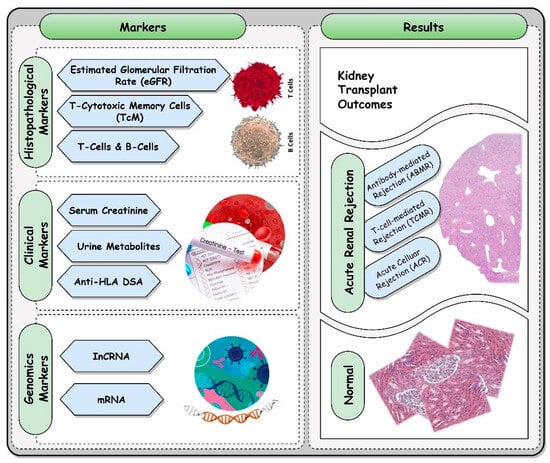
Figure 1
Open AccessReview
Mesenchymal Stem Cells Derived from Human Periapical Cysts and Their Implications in Regenerative Medicine
Biomedicines 2023, 11(9), 2436; https://doi.org/10.3390/biomedicines11092436 - 31 Aug 2023
Abstract
Mesenchymal stem cells currently play an important role in the tissue engineering field in developing new regenerative approaches. The oral cavity is a rich source of mesenchymal stem cells, and introducing the use of dental stem cells, characterized by a multilineage differentiation potential,
[...] Read more.
Mesenchymal stem cells currently play an important role in the tissue engineering field in developing new regenerative approaches. The oral cavity is a rich source of mesenchymal stem cells, and introducing the use of dental stem cells, characterized by a multilineage differentiation potential, immunomodulatory activity and repair capacity, offers a good perspective for clinical dentistry. Human periapical cyst mesenchymal stem cells (hPCy-MSCs) represent a new category of dental stem cells, being collected from pathological tissue and exhibiting MSCs-like properties. As studies have described, these new identified cells possess the same characteristics as those described in MSCs, exhibiting plasticity, a high proliferation rate and the potential to differentiate into osteogenic, adipogenic and neural lineages. Reusing the biological tissue that is considered pathologic offers a new perspective for the development of further clinical applications. The identification and characterization of MSCs in the human periapical cysts allows for a better understanding of the molecular interactions, the potential healing capacity and the mechanisms of inducing the local osteogenic process, integrated in the microenvironment. Although their involvement in regenerative medicine research is recent, they exhibit important properties that refer them for the development of clinical applications in dentistry.
Full article
(This article belongs to the Special Issue Cell Biology in Dentistry)
►▼
Show Figures
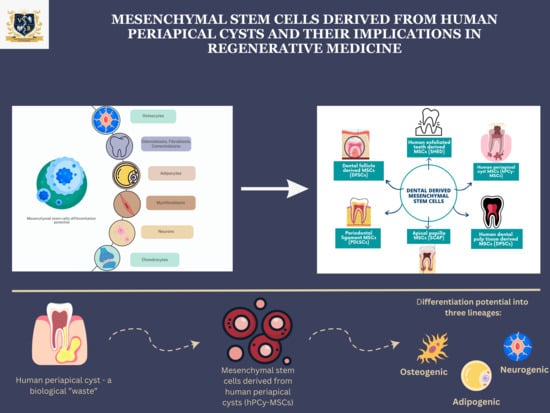
Graphical abstract
Open AccessArticle
Handgrip Strength Is Associated with Specific Aspects of Vascular Function in Individuals with Metabolic Syndrome
by
, , , , , , , , and
Biomedicines 2023, 11(9), 2435; https://doi.org/10.3390/biomedicines11092435 - 31 Aug 2023
Abstract
Background: Metabolic syndrome (MetS) is a disorder associated with an increased risk for the development of diabetes mellitus and its complications. Lower isometric handgrip strength (HGS) is associated with an increased risk of cardiometabolic diseases. However, the association between HGS and arterial stiffness
[...] Read more.
Background: Metabolic syndrome (MetS) is a disorder associated with an increased risk for the development of diabetes mellitus and its complications. Lower isometric handgrip strength (HGS) is associated with an increased risk of cardiometabolic diseases. However, the association between HGS and arterial stiffness parameters, which are considered the predictors of morbidity and mortality in individuals with MetS, is not well defined. Objective: To determine the association between HGS and HGS asymmetry on components of vascular function in adults with MetS. Methods: We measured handgrip strength normalized to bodyweight (HGS/kg), HGS asymmetry, body composition, blood glucose, lipid profile, blood pressure, pulse wave velocity (PWV), reflection coefficient (RC), augmentation index @75 bpm (AIx@75) and peripheral vascular resistance (PVR) in 55 adults with a diagnosis of MetS between 25 and 54 years old. Results: Mean age was 43.1 ± 7.0 years, 56.3% were females. HGS/kg was negatively correlated with AIx@75 (r = −0.440), p < 0.05, but these associations were not significant after adjusting for age and sex. However, when interaction effects between sex, HGS/kg and age were examined, we observed an inverse relationship between HGS/kg and AIx@75 in the older adults in the sample, whereas in the younger adults, a weak direct association was found. We also found a significant association between HGS asymmetry and PVR (beta = 30, 95% CI = 7.02; 54.2; p <0.012). Conclusions: Our findings suggest that in people with MetS, maintaining muscle strength may have an increasingly important role in older age in the attenuation of age-related increases in AIx@75—a marker of vascular stiffness—and that a higher HGS asymmetry could be associated with a greater vascular resistance.
Full article
(This article belongs to the Special Issue Cardiovascular and Metabolic Disease: New Treatment and Future Directions 2.0)
►▼
Show Figures
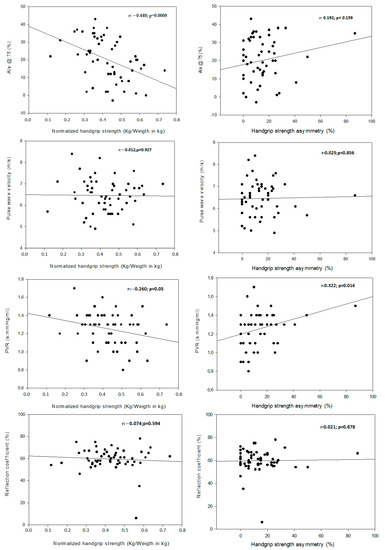
Figure 1
Open AccessArticle
Creation of an iPSC-Based Skeletal Muscle Model of McArdle Disease Harbouring the Mutation c.2392T>C (p.Trp798Arg) in the PYGM Gene
Biomedicines 2023, 11(9), 2434; https://doi.org/10.3390/biomedicines11092434 - 31 Aug 2023
Abstract
McArdle disease is a rare autosomal recessive condition caused by mutations in the PYGM gene. This gene encodes the skeletal muscle isoform of glycogen phosphorylase or myophosphorylase. Patients with McArdle disease have an inability to obtain energy from their muscle glycogen stores, which
[...] Read more.
McArdle disease is a rare autosomal recessive condition caused by mutations in the PYGM gene. This gene encodes the skeletal muscle isoform of glycogen phosphorylase or myophosphorylase. Patients with McArdle disease have an inability to obtain energy from their muscle glycogen stores, which manifests as a marked exercise intolerance. Nowadays, there is no cure for this disorder and recommendations are intended to prevent and mitigate symptoms. There is great heterogeneity among the pathogenic variants found in the PYGM gene, and there is no obvious correlation between genotypes and phenotypes. Here, we present the generation of the first human iPSC-based skeletal muscle model harbouring the second most frequent mutation in PYGM in the Spanish population: NM_005609.4: c.2392T>C (p.Trp798Arg). To this end, iPSCs derived from a McArdle patient and a healthy control were both successfully differentiated into skeletal muscle cells using a small molecule-based protocol. The created McArdle skeletal muscle model was validated by confirming distinctive biochemical aspects of the disease such as the absence of myophosphorylase, the most typical biochemical feature of these patients. This model will be very valuable for use in future high-throughput pharmacological screenings.
Full article
(This article belongs to the Special Issue 10th Anniversary of Biomedicines—Induced Pluripotent Stem Cells: 15 Years after the Discovery)
►▼
Show Figures
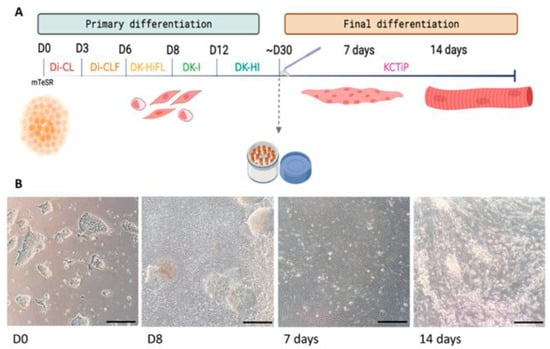
Figure 1
Open AccessArticle
Cut-off Value for Thyroglobulin Washout Concentration in the Detection of Cervical Lymph Node Metastases in Patients after Thyroidectomy Due to Differentiated Thyroid Cancer
by
, , , , and
Biomedicines 2023, 11(9), 2433; https://doi.org/10.3390/biomedicines11092433 - 31 Aug 2023
Abstract
The aim of this study was to establish the cut-off value for the thyroglobulin (Tg) concentration in washout fluid from fine needle aspiration biopsy (FNA-Tg) in the detection of cervical lymph node metastases of differentiated thyroid cancer (DTC). We evaluated the validity and
[...] Read more.
The aim of this study was to establish the cut-off value for the thyroglobulin (Tg) concentration in washout fluid from fine needle aspiration biopsy (FNA-Tg) in the detection of cervical lymph node metastases of differentiated thyroid cancer (DTC). We evaluated the validity and clinical utility of fine needle aspiration biopsy cytology (FNAB-C), FNA-Tg, and the combined method in detecting DTC recurrences. The study included 82 patients after the total thyroidectomy and elective and, in some cases, also selective cervical lymphadenectomy. The majority of patients also underwent subsequent 131I ablative therapy. The patients presented with 1–6 enlarged and/or ultrasonographically suspicious cervical lymph nodes. One to four aspirates of each lymph node were taken, with a total of 297 samples. An FNA-Tg of 4.34 ng/mL was established as the cut-off value for detecting cervical lymph node DTC metastases for the IRMA Brahms DYNO test, Tg-S. FNAB-C is highly specific (91–99%) but not sensitive enough (53–69%) to be used as a standalone method in the detection of cervical lymph node metastases. FNA-Tg is more sensitive (91%), but caution should be taken when selecting patients for surgery with an FNA-Tg higher than the established cut-off value but lower than the serum Tg concentration. To select patients for lymphadenectomy, we recommend using the combined method (FNAB-C and FNA-Tg) with a sensitivity of 96% and specificity of up to 97%. More than one sample should be taken with each fine needle aspiration biopsy (FNAB) to obtain a representative set of samples.
Full article
(This article belongs to the Special Issue Thyroid Disease: From Mechanism to Therapeutic Approaches)
►▼
Show Figures
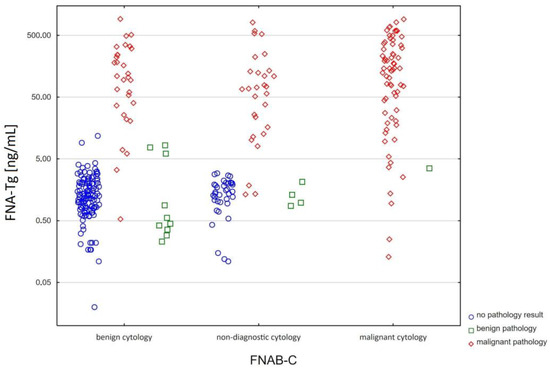
Figure 1
Open AccessArticle
Prevalence of Unfavorable Video-Urodynamic Findings and Clinical Implications in Patients with Minimally Conscious State/Unresponsive Wakefulness Syndrome: A Retrospective Descriptive Analysis
by
, , , , , , , and
Biomedicines 2023, 11(9), 2432; https://doi.org/10.3390/biomedicines11092432 - 31 Aug 2023
Abstract
The aim of this retrospective exploratory study was to investigate the prevalence of unfavorable findings during video-urodynamic studies (VUDS) in patients with minimally conscious state (MCS)/unresponsive wakefulness syndrome (UWS) and whether management of the lower urinary tract (LUT) was adjusted accordingly. A retrospective
[...] Read more.
The aim of this retrospective exploratory study was to investigate the prevalence of unfavorable findings during video-urodynamic studies (VUDS) in patients with minimally conscious state (MCS)/unresponsive wakefulness syndrome (UWS) and whether management of the lower urinary tract (LUT) was adjusted accordingly. A retrospective chart review was conducted to screen for patients diagnosed with MCS/UWS at our rehabilitation center between 2011 and 2020. Patients 18 years or older were included and underwent baseline VUDS after being diagnosed with MCS/UWS. We analyzed urodynamic parameters and subsequent changes in LUT management in this cohort. In total, 32 patients (7 females, 25 males, median age 37 years) with MCS/UWS were included for analysis. While at least one unfavorable VUDS finding (i.e., neurogenic detrusor overactivity [NDO], detrusor sphincter dyssynergia {DSD, high maximum detrusor pressure during storage phase [>40 cmH2O], low-compliance bladder [<20 mL/cmH2O], and vesico–uretero–renal reflux [VUR]) was found in each patient, NDO (78.1%, 25/32) and DSD (68.8%, 22/32) were the two most frequent unfavorable VUDS findings. Following baseline VUDS, new LUT treatment options were established in 56.3% (18/32) of all patients. In addition, bladder-emptying methods were changed in 46.9% (15/32) of all patients, resulting in fewer patients relying on indwelling catheters. Our retrospective exploratory study revealed a high prevalence of NDO and DSD in patients with MCS/UWS, illustrating the importance of VUDS to adapt LUT management in this cohort accordingly.
Full article
(This article belongs to the Special Issue Bench to Bedside in Neuro-Urology)
►▼
Show Figures
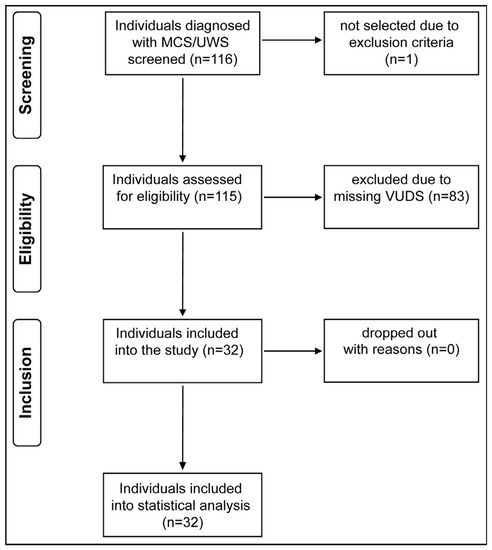
Figure 1
Open AccessArticle
The Multi-Kinase Inhibitor RepSox Enforces Barrier Function in the Face of Both VEGF and Cytokines
Biomedicines 2023, 11(9), 2431; https://doi.org/10.3390/biomedicines11092431 - 31 Aug 2023
Abstract
The therapeutic benefit provided by anti-vascular endothelial growth factor (VEGF) for patients with vision-threatening conditions such as diabetic retinopathy (DR) demonstrates the important role of VEGF in this affliction. Cytokines, which can be elevated in the vitreous of patients with DR, promote leakage
[...] Read more.
The therapeutic benefit provided by anti-vascular endothelial growth factor (VEGF) for patients with vision-threatening conditions such as diabetic retinopathy (DR) demonstrates the important role of VEGF in this affliction. Cytokines, which can be elevated in the vitreous of patients with DR, promote leakage of retinal blood vessels, and may also contribute to pathology, especially in those patients for whom anti-VEGF does not provide adequate benefit. In this in vitro study using primary human retinal endothelial cells, we compared anti-VEGF with the (transforming growth factor beta) TGFβ receptor inhibitor RepSox (RS) for their ability to enforce barrier function in the face of VEGF, cytokines, and the combination of both. RS was superior to anti-VEGF because it prevented permeability in response to VEGF, cytokines, and their combination, whereas anti-VEGF was effective against VEGF alone. The inhibitory effect of RS was associated with suppression of both agonist-induced pore formation and disorganization of adherens junctions. RS-mediated inhibition of the TGFβ pathway and increased expression of claudin-5 did not adequately explain how RS stabilized the endothelial cell barrier. Finally, RS not only prevented barrier relaxation, but also completely or partially reclosed a barrier relaxed with tumor necrosis factor α (TNF α) or VEGF, respectively. These studies demonstrate that RS stabilized the endothelial barrier in the face of both cytokines and VEGF, and thereby identify RS as a therapeutic that has the potential to overcome permeability driven by multiple agonists that play a role in the pathology of DR.
Full article
(This article belongs to the Special Issue New Diagnostic and Therapeutic Approaches in Diabetic Microvascular Complications)
►▼
Show Figures
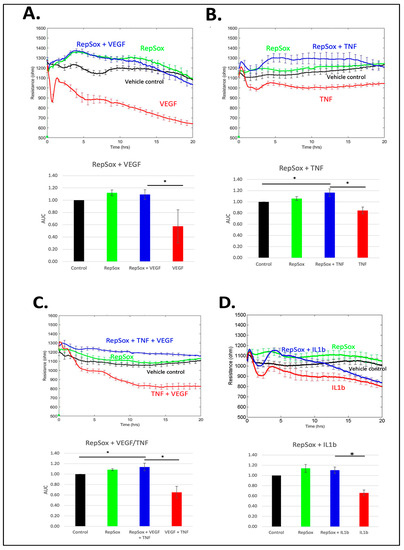
Figure 1
Open AccessReview
Is There a Relationship between Adverse Pregnancy Outcomes and Future Development of Atherosclerosis?
by
, , , , and
Biomedicines 2023, 11(9), 2430; https://doi.org/10.3390/biomedicines11092430 - 31 Aug 2023
Abstract
Cardiovascular disease is one of the main death causes globally. Effective cardiovascular risk management requires a thorough understanding of the mechanisms underlying the disorder. Establishing early markers of the disease allows a timely intervention and prevention of further atherosclerosis development. Multiple studies confirm
[...] Read more.
Cardiovascular disease is one of the main death causes globally. Effective cardiovascular risk management requires a thorough understanding of the mechanisms underlying the disorder. Establishing early markers of the disease allows a timely intervention and prevention of further atherosclerosis development. Multiple studies confirm the correlation between pregnancy disorders and cardiovascular disease in the postpartum period. Moreover, over 30% of women experience adverse pregnancy outcomes. Thus, the examination of the links between these conditions and atherosclerotic cardiovascular disease may help to identify gender-specific risk factors. In this review, we will explore the association between several adverse pregnancy outcome conditions and atherosclerosis. The current analysis is based on the data from several recent studies on the mechanisms behind gestational diabetes, hypertensive disorders of pregnancy, miscarriages, and stillbirths and their implications for the female cardiovascular system.
Full article
(This article belongs to the Special Issue Advanced Research on Gestational Diabetes: Focus on Fetal and Placental Endothelial Function)
►▼
Show Figures
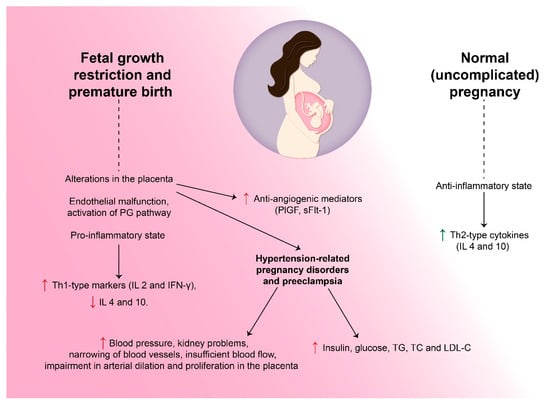
Figure 1
Open AccessReview
Current Approaches in the Multimodal Management of Asthma in Adolescents—From Pharmacology to Personalized Therapy
by
, , , , , , , , , , , and
Biomedicines 2023, 11(9), 2429; https://doi.org/10.3390/biomedicines11092429 - 30 Aug 2023
Abstract
Asthma and adolescence are two sensitive points and are difficult to manage when they coexist. The first is a chronic respiratory condition, with frequent onset in early childhood (between 3 and 5 years), which can improve or worsen with age. Adolescence is the
[...] Read more.
Asthma and adolescence are two sensitive points and are difficult to manage when they coexist. The first is a chronic respiratory condition, with frequent onset in early childhood (between 3 and 5 years), which can improve or worsen with age. Adolescence is the period between childhood and adulthood (12–19 years), marked by various internal and external conflicts and a limited capacity to understand and accept any aspect that is delimited by the pattern of the social circle (of the entourage) frequented by the individual. Therefore, the clinician is faced with multiple attempts regarding the management of asthma encountered during the adolescent period, starting from the individualization of the therapy to the control of compliance (which depends equally on the adverse reactions, quality of life offered and support of the close circle) and the social integration of the subject, communication probably having a more important role in the monitoring and evolution of the condition than the preference for a certain therapeutic scheme. Current statistics draw attention to the increase in morbidity and mortality among children with bronchial asthma, an aspect demonstrated by the numerous hospitalizations recorded, due either to an escalation in the severity of this pathology or to faulty management. The purpose of this article is to review the delicate aspects in terms of controlling symptoms and maintaining a high quality of life among teenagers.
Full article
(This article belongs to the Special Issue Emerging Issues in Asthma)
►▼
Show Figures
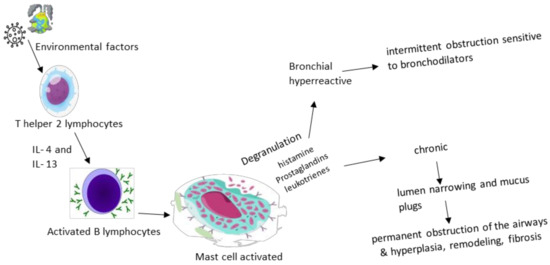
Figure 1
Open AccessArticle
Exploring the Synthetic Chemistry of Phenyl-3-(5-aryl-2-furyl)- 2-propen-1-ones as Urease Inhibitors: Mechanistic Approach through Urease Inhibition, Molecular Docking and Structure–Activity Relationship
by
, , , , , , , , , and
Biomedicines 2023, 11(9), 2428; https://doi.org/10.3390/biomedicines11092428 - 30 Aug 2023
Abstract
Furan chalcone scaffolds belong to the most privileged and promising oxygen-containing heterocyclic class of compounds, which have a wide spectrum of therapeutic applications in the field of pharmaceutics, pharmacology, and medicinal chemistry. This research described the synthesis of a series of twelve novel
[...] Read more.
Furan chalcone scaffolds belong to the most privileged and promising oxygen-containing heterocyclic class of compounds, which have a wide spectrum of therapeutic applications in the field of pharmaceutics, pharmacology, and medicinal chemistry. This research described the synthesis of a series of twelve novel and seven reported furan chalcone (conventional synthetic approach) analogues 4a–s through the application of microwave-assisted synthetic methodology and evaluated for therapeutic inhibition potential against bacterial urease enzyme. In the first step, a series of nineteen substituted 5-aryl-2-furan-2-carbaldehyde derivatives 3a–s were achieved in moderate to good yields (40–70%). These substituted 5-aryl-2-furan-2-carbaldehyde derivatives 3a–s were condensed with acetophenone via Claisen–Schmidt condensation to furnish 19 substituted furan chalcone scaffolds 4a–s in excellent yields (85–92%) in microwave-assisted synthetic approach, while in conventional methodology, these furan chalcone 4a–s were furnished in good yield (65–90%). Furan chalcone structural motifs 4a–s were characterized through elemental analysis and spectroscopic techniques. These nineteen (19)-afforded furan chalcones 4a–s were screened for urease inhibitory chemotherapeutic efficacy and most of the furan chalcones displayed promising urease inhibition activity. The most active urease inhibitors were 1-phenyl-3-[5-(2′,5′-dichlorophenyl)-2-furyl]-2–propen-1-one 4h with an IC50 value of 16.13 ± 2.45 μM, and 1-phenyl- 3-[5-(2′-chlorophenyl)-2-furyl] -2-propen-1-one 4s with an IC50 value of 18.75 ± 0.85 μM in comparison with reference drug thiourea (IC50 = 21.25 ± 0.15 μM). These furan chalcone derivatives 4h and 4s are more efficient urease inhibitors than reference drug thiourea. Structure–activity relationship (SAR) revealed that the 2,5-dichloro 4h and 2-chloro 4s moiety containing furan chalcone derivatives may be considered as potential lead reagents for urease inhibition. The in silico molecular docking study results are in agreement with the experimental biological findings. The results of this study may be helpful in the future drug discovery and designing of novel efficient urease inhibitory agents from this biologically active class of furan chalcones.
Full article
(This article belongs to the Special Issue Medicinal Chemistry in Drug Design and Discovery)
►▼
Show Figures
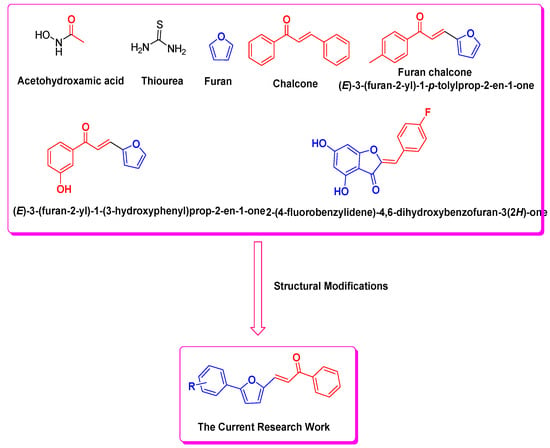
Figure 1
Open AccessReview
Pollutants, including Organophosphorus and Organochloride Pesticides, May Increase the Risk of Cardiac Remodeling and Atrial Fibrillation: A Narrative Review
Biomedicines 2023, 11(9), 2427; https://doi.org/10.3390/biomedicines11092427 - 30 Aug 2023
Abstract
Atrial fibrillation (AF) is the most common type of cardiac rhythm disorder. Recent clinical and experimental studies reveal that environmental pollutants, including organophosphorus–organochloride pesticides and air pollution, may contribute to the development of cardiac arrhythmias including AF. Here, we discussed the unifying cascade
[...] Read more.
Atrial fibrillation (AF) is the most common type of cardiac rhythm disorder. Recent clinical and experimental studies reveal that environmental pollutants, including organophosphorus–organochloride pesticides and air pollution, may contribute to the development of cardiac arrhythmias including AF. Here, we discussed the unifying cascade of events that may explain the role of pollutant exposure in the development of AF. Following ingestion and inhalation of pollution-promoting toxic compounds, damage-associated molecular pattern (DAMP) stimuli activate the inflammatory response and oxidative stress that may negatively affect the respiratory, cognitive, digestive, and cardiac systems. Although the detailed mechanisms underlying the association between pollutant exposure and the incidence of AF are not completely elucidated, some clinical reports and fundamental research data support the idea that pollutant poisoning can provoke perturbed ion channel function, myocardial electrical abnormalities, decreased action potential duration, slowed conduction, contractile dysfunction, cardiac fibrosis, and arrhythmias including AF.
Full article
(This article belongs to the Special Issue Early Diagnosis, Pathogenesis and Treatment Strategies of Atrial Fibrillation)
►▼
Show Figures
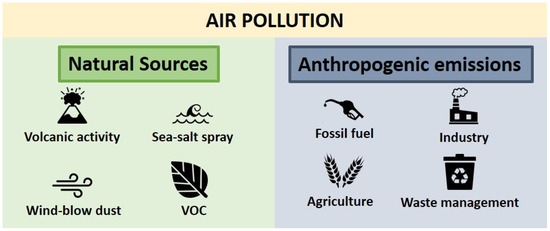
Figure 1
Open AccessArticle
Finding the Common Single-Nucleotide Polymorphisms in Three Autoimmune Diseases and Exploring Their Bio-Function by Using a Reporter Assay
Biomedicines 2023, 11(9), 2426; https://doi.org/10.3390/biomedicines11092426 - 30 Aug 2023
Abstract
In clinical practice, it is found that autoimmune thyroid disease often additionally occurs with systemic lupus erythematosus (SLE) and rheumatoid arthritis (RA). In addition, several studies showed that eye-specific autoimmune diseases may have a strong relationship with systemic autoimmune diseases. We focused on
[...] Read more.
In clinical practice, it is found that autoimmune thyroid disease often additionally occurs with systemic lupus erythematosus (SLE) and rheumatoid arthritis (RA). In addition, several studies showed that eye-specific autoimmune diseases may have a strong relationship with systemic autoimmune diseases. We focused on Graves’ disease (GD) with ocular conditions, also known as Graves’ ophthalmopathy (GO), trying to find out the potential genetic background related to GO, RA, and SLE. There were 40 GO cases and 40 healthy controls enrolled in this study. The association between single-nucleotide polymorphisms (SNPs) of the co-stimulatory molecule genes and GO was analyzed using a chi-square test. It showed that rs11571315, rs733618, rs4553808, rs11571316, rs16840252, and rs11571319 of CTLA4, rs3181098 of CD28, rs36084323 and rs10204525 of PDCD1, and rs11889352 and rs4675379 of ICOS were significantly associated with GO based on genotype analysis and/or allele analysis (p < 0.05). After summarizing the GO data and the previously published SLE and RA data, it was found that rs11571315, rs733618, rs4553808, rs16840252, rs11571319, and rs36084323 were shared in these three diseases. Furthermore, the bio-function was confirmed by dual-luciferase reporter assay. It was shown that rs733618 T > C and rs4553808 A > G significantly decreased the transcriptional activity (both p < 0.001). This study is the first to confirm that these three diseases share genetically predisposing factors, and our results support the proposal that rs733618 T > C and rs4553808 A > G have bio-functional effects on the transcriptional activity of the CTLA4 gene.
Full article
(This article belongs to the Section Molecular Genetics and Genetic Diseases)
►▼
Show Figures
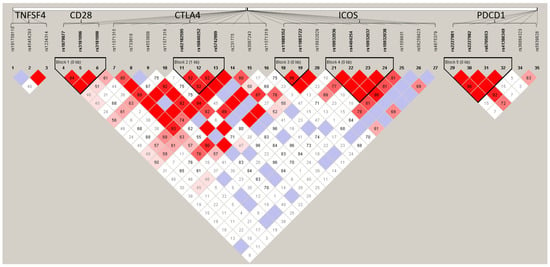
Figure 1
Open AccessEditorial
Red Blood Cells in Platelet-Rich Plasma: Avoid If at All Possible
Biomedicines 2023, 11(9), 2425; https://doi.org/10.3390/biomedicines11092425 - 30 Aug 2023
Abstract
The last decade has seen a noticeable upsurge in the use of biologics, including platelet-rich plasma (PRP), for applications in musculoskeletal regenerative medicine [...]
Full article
(This article belongs to the Special Issue Biologics for Bone and Soft Tissue Regeneration: What Is New, What Is True)
Open AccessArticle
Long-Term Efficacy of Mepolizumab at 3 Years in Patients with Severe Asthma: Comparison with Clinical Trials and Super Responders
by
, , , , , , , , , , , , , , , , , , , , , , , , , , , , and on behalf of SANIadd
Show full author list
remove
Hide full author list
Biomedicines 2023, 11(9), 2424; https://doi.org/10.3390/biomedicines11092424 - 30 Aug 2023
Abstract
The efficacy mepolizumab in severe asthmatic patients is proven in the literature. Primarily to study the effect of mepolizumab on exacerbations, steroid dependence, and the continuation of efficacy in the long term. Secondarily to evaluate the effect of the drug on nasal polyps.
[...] Read more.
The efficacy mepolizumab in severe asthmatic patients is proven in the literature. Primarily to study the effect of mepolizumab on exacerbations, steroid dependence, and the continuation of efficacy in the long term. Secondarily to evaluate the effect of the drug on nasal polyps. Analyzing data from SANI (Severe Asthma Network Italy) clinics, we observed severe asthmatic patients treated with mepolizumab 100 mg/4 weeks, for a period of 3 years. 157 patients were observed. Exacerbations were reduced from the first year (−84.6%) and progressively to 90 and 95% in the second and third ones. Steroid-dependent patients decreased from 54% to 21% and subsequently to 11% in the second year and 6% in the third year. Patients with concomitant nasal polyps, assessed by SNOT-22, showed a 49% reduction in value from baseline to the third year. The study demonstrated the long-term efficacy of mepolizumab in a real-life setting.
Full article
(This article belongs to the Special Issue Advances in Respiratory Allergies)
►▼
Show Figures

Figure 1
Open AccessArticle
Low CRB-65 Scores Effectively Rule out Adverse Clinical Outcomes in COVID-19 Irrespective of Chest Radiographic Abnormalities
by
, , , , , , , , , , , , and
Biomedicines 2023, 11(9), 2423; https://doi.org/10.3390/biomedicines11092423 - 30 Aug 2023
Abstract
Background: CRB-65 (Confusion; Respiratory rate ≥ 30/min; Blood pressure ≤ 90/60 mmHg; age ≥ 65 years) is a risk score for prognosticating patients with COVID-19 pneumonia. However, a significant proportion of COVID-19 patients have normal chest X-rays (CXRs). The
[...] Read more.
Background: CRB-65 (Confusion; Respiratory rate ≥ 30/min; Blood pressure ≤ 90/60 mmHg; age ≥ 65 years) is a risk score for prognosticating patients with COVID-19 pneumonia. However, a significant proportion of COVID-19 patients have normal chest X-rays (CXRs). The influence of CXR abnormalities on the prognostic value of CRB-65 is unknown, limiting its wider applicability. Methods: We assessed the influence of CXR abnormalities on the prognostic value of CRB-65 in COVID-19. Results: In 589 study patients (71 years (IQR: 57–83); 57% males), 186 (32%) had normal CXRs. On ROC analysis, CRB-65 performed similarly in patients with normal vs. abnormal CXRs for predicting inpatient mortality (AUC 0.67 ± 0.05 vs. 0.69 ± 0.03). In patients with normal CXRs, a CRB-65 of 0 ruled out mortality, NIV requirement and critical illness (intubation and/or ICU admission) with negative predictive values (NPVs) of 94%, 98% and 99%, respectively. In patients with abnormal CXRs, a CRB-65 of 0 ruled out the same endpoints with NPVs of 91%, 83% and 86%, respectively. Patients with low CRB-65 scores had better inpatient survival than patients with high CRB-65 scores, irrespective of CXR abnormalities (all p < 0.05). Conclusions: CRB-65, CXR and CRP are independent predictors of mortality in COVID-19. Adding CXR findings (dichotomised to either normal or abnormal) to CRB-65 does not improve its prognostic accuracy. A low CRB-65 score of 0 may be a good rule-out test for adverse clinical outcomes in COVID-19 patients with normal or abnormal CXRs, which deserves prospective validation.
Full article
(This article belongs to the Section Molecular and Translational Medicine)
►▼
Show Figures
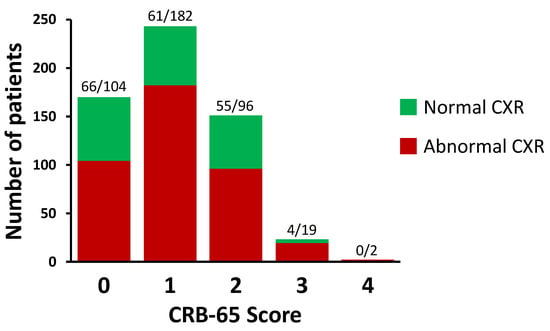
Figure 1
Open AccessArticle
Diagnostic Performance of Serum MicroRNAs for ST-Segment Elevation Myocardial Infarction in the Emergency Department
by
, , , , , , , , , , , , , , , , , , and
Biomedicines 2023, 11(9), 2422; https://doi.org/10.3390/biomedicines11092422 - 30 Aug 2023
Abstract
Prompt diagnosis of ST-segment elevation myocardial infarction (STEMI) is essential for initiating timely treatment. MicroRNAs have recently emerged as biomarkers in cardiovascular diseases. This study aimed to evaluate the discriminatory capacity of serum microRNAs in identifying an ischemic origin in patients presenting with
[...] Read more.
Prompt diagnosis of ST-segment elevation myocardial infarction (STEMI) is essential for initiating timely treatment. MicroRNAs have recently emerged as biomarkers in cardiovascular diseases. This study aimed to evaluate the discriminatory capacity of serum microRNAs in identifying an ischemic origin in patients presenting with chest discomfort to the Emergency Department. The study included 98 participants (78 with STEMI and 20 with nonischemic chest discomfort). Significant differences in the expression levels of miR-133b, miR-126, and miR-155 (but not miR-1, miR-208, and miR-208b) were observed between groups. miR-133b and miR-155 exhibited 97% and 93% sensitivity in identifying STEMI patients, respectively. miR-126 demonstrated a specificity of 90% in identifying STEMI patients. No significant associations were found between microRNAs and occurrence of major adverse cardiovascular events (MACE). However, patients with MACE had higher levels of interleukin (IL)-15, IL-21, IFN-γ-induced protein-10, and N-terminal pro B-type natriuretic peptide compared to non-MACE patients. Overall, there were significant associations among the expression levels of microRNAs. However, microRNAs did not demonstrate associations with either inflammatory markers or cardiovascular risk scores. This study highlights the potential of microRNAs, particularly miR-133b and miR-126, as diagnostic biomarkers for distinguishing patients with STEMI from those presenting with nonischemic chest discomfort to the Emergency Department.
Full article
(This article belongs to the Special Issue microRNAs as Biomarkers of Cardiovascular Diseases 2.0)
►▼
Show Figures
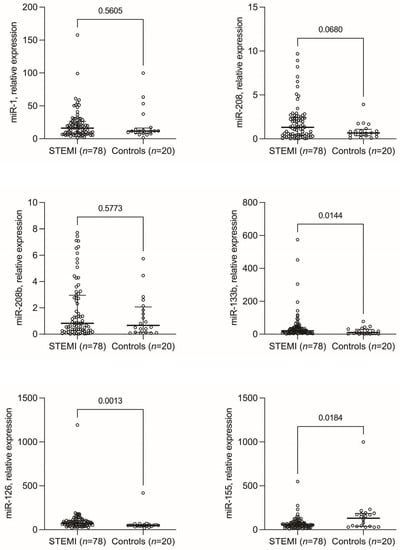
Figure 1

Journal Menu
► ▼ Journal Menu-
- Biomedicines Home
- Aims & Scope
- Editorial Board
- Reviewer Board
- Topical Advisory Panel
- Instructions for Authors
- Special Issues
- Topics
- Sections & Collections
- Article Processing Charge
- Indexing & Archiving
- Editor’s Choice Articles
- Most Cited & Viewed
- Journal Statistics
- Journal History
- Journal Awards
- Society Collaborations
- Conferences
- Editorial Office
Journal Browser
► ▼ Journal BrowserHighly Accessed Articles
Latest Books
E-Mail Alert
News
Topics
Topic in
Biology, Biomedicines, Cancers, Current Oncology, Onco
Targeting Signaling Networks for Cancer Therapy
Topic Editors: Renato Bassan, Jose-Maria Ribera, Linlin GuoDeadline: 5 September 2023
Topic in
Biomechanics, Biomedicines, Brain Sciences, Materials, Nanomaterials
Biomechanics and Biomaterial Engineering in Neurological Disorders
Topic Editors: Seifollah Gholampour, Mohammad Reza SafaeiDeadline: 30 September 2023
Topic in
Biomedicines, Cancers, Current Oncology, ncRNA, Onco
Non-coding RNAs in Cancer: Markers in Disease Progression and Therapy
Topic Editors: Balaji Krishnamachary, Oliver TreeckDeadline: 31 October 2023
Topic in
Biomedicines, Diseases, Endocrines, Healthcare, JCM
Diagnosis and Treatment of Pituitary-Related Disorders
Topic Editors: Elzbieta Skowronska-Jozwiak, Krzysztof C. LewandowskiDeadline: 20 November 2023

Conferences
Special Issues
Special Issue in
Biomedicines
Pathogenesis and Counteracting Strategies of Hepatocellular Carcinoma, Cholangiocarcinoma and Urothelial Carcinoma
Guest Editor: Kung-Hao LiangDeadline: 15 September 2023
Special Issue in
Biomedicines
Tuberculosis and Latent Tuberculosis Infection: Molecular Basis and Translational Research
Guest Editors: Jann-Yuan Wang, Horng-Yunn Dou, Abhishek MishraDeadline: 30 September 2023
Special Issue in
Biomedicines
Molecular Mechanisms of Normal and Malignant Hematopoiesis
Guest Editor: Myunggon KoDeadline: 15 October 2023
Special Issue in
Biomedicines
New Advance in Immuno-Oncology
Guest Editor: Concetta Elisa OnestiDeadline: 31 October 2023
Topical Collections
Topical Collection in
Biomedicines
OMICs and Complex Diseases
Collection Editors: Mostafa Dianatinasab, Anke Wesselius, Amin Salehi-Abargouei
Topical Collection in
Biomedicines
Feature Papers in Cancer Biology and Therapeutics
Collection Editor: Veronique Baud
Topical Collection in
Biomedicines
Feature Papers in Gene and Cell Therapy
Collection Editor: Bernard Lebleu
Topical Collection in
Biomedicines
Feature Papers in Microbiology in Human Health and Disease
Collection Editor: Ryota Niikura




